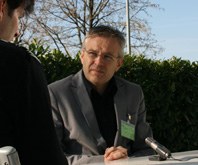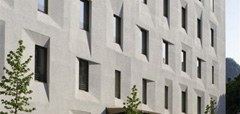News
A cool head in conversation: Norbert Lantschner, Director of the ClimateHouse Agency in Bolzano/I "The cleanest energy is the energy I don't need"
Aug 03, 2009
/
cc.alps
The ClimateHouse Agency in Bolzano has won one of the seven prizes of the CIPRA's cc.alps Competition for its energy saving initiatives. We spoke to its Director, Norbert Lantschner at our "Cool Heads in the Hothouse" conference.

Image caption:
Norbert Lantschner, Director of the ClimateHouse Agency in Bolzano. © CIPRA International

Image caption:
Former Post Office building Bolzano/I. This is the first publicly refurbished “passive house” (ClimateHouse Gold) in Italy. The original building dates back to 1954. © LudwigThalheimer
Interview: Stefan Arlanch, CIPRA International. The complete interview on video is available in German at: www.cipra.org/de/climalp/lantschner.
Mr Norbert Lantschner, what is the purpose of ClimateHouse?
With ClimateHouse we are trying to put our guiding principle, i.e. "the cleanest energy is the energy I don't need" into practice. If you consider that almost half the world's energy consumption is channelled through buildings, what this area of work needs to look like. Our first priority is to modernise buildings to make them more energy efficient; we need to design different buildings. And so we have a tremendous task ahead of us in the coming years, to improve the energy efficiency of these buildings, particularly those built in the post-war years.
What were the biggest challenges faced by ClimateHouse?The ClimateHouse concept developed from the idea of closing the gap between a high level of knowledge and available technologies and a low level of action. ClimateHouse's challenge was to bridge this divide. We have tried to get all the players round the table: the planners, the craftsmen, the construction companies, the public authorities and of the course the people who have to live in the houses. And we have managed to get things done in just a short time, because the individual person is now placed firmly at the centre. That is, a person who builds or modernises a house needs to be given all the support available to achieve a high standard of quality: a high degree of living comfort, minimum consumption and of course, protection of the environment and climate.
As a winner of CIPRA's cc.alps competition ClimateHouse received €10,000. What is ClimateHouse going to do with the prize money?
We want to use the prize money to pass on our wealth of experience to others. For example, in Slovenia we are helping to realise a project based on our core energy saving concepts. Because if we want to overcome this climate crisis, we need to act globally. We need to win over as many players as possible to participate actively in this process.
How do you see the opportunities for passing on knowledge and experience within Italy itself?
We already have projects under way in Friuli-Venezia Giulia. And projects based on the ClimateHouse concept have recently been started in Sondrio/I. Italy is currently lagging behind in the EU as far as the reduction of CO2 emissions and energy dependency is concerned. This means that there is tremendous scope for modernising buildings and building new ones. In some Italian regions there are already projects which are about to start this process with ClimateHouse.
Finally: Where do you see the future of construction?
The first step will be to maximise energy efficiency. The second will be to design ecologically compatible buildings. It's not just designing a building that requires little or no energy that counts, but also how I go about it. The third step is therefore establishing where this house will be built. Because there is little sense in building a zero-energy house halfway up a mountain, if its residents then have to use big four-wheel drives every day to get to work. In the Alpine region we have the particular issue of how to approach the extremely scant resource of space. And even then we will need to think about how we can permit this development in the Alpine region, where tourism is in many places the main source of income. What am I going to do about these tourist facilities which put considerable pressure on space?
The ClimateHouse building certification stands for energy savings, a high degree of comfortable living and active climate protection:
* Country: South Tyrol/Italy
* From 2002 to 2008 over 1,000 buildings have been certified to the ClimateHouse Standard.
* The ClimateHouses built or renovated in South Tyrol save 6,000 tonnes of CO2 a year. This is equivalent to 3 million litres of heating oil.
* The three columns of Climate House: awareness raising, education, counselling.
* Modern and careful planning according to the ClimateHouse Standard can reduce the use of building cooling systems especially in southern latitudes.
* The annual energy savings may even be as much as an average monthly salary for individual families.
* 2008: Prize winner of the CIPRA cc.alps competition.
Further info under: www.cipra.org/de/cc.alps/wettbewerb/klimahaus (de/fr/it/sl) and www.cipra.org/competition-cc.alps (de)
Mr Norbert Lantschner, what is the purpose of ClimateHouse?
With ClimateHouse we are trying to put our guiding principle, i.e. "the cleanest energy is the energy I don't need" into practice. If you consider that almost half the world's energy consumption is channelled through buildings, what this area of work needs to look like. Our first priority is to modernise buildings to make them more energy efficient; we need to design different buildings. And so we have a tremendous task ahead of us in the coming years, to improve the energy efficiency of these buildings, particularly those built in the post-war years.
What were the biggest challenges faced by ClimateHouse?The ClimateHouse concept developed from the idea of closing the gap between a high level of knowledge and available technologies and a low level of action. ClimateHouse's challenge was to bridge this divide. We have tried to get all the players round the table: the planners, the craftsmen, the construction companies, the public authorities and of the course the people who have to live in the houses. And we have managed to get things done in just a short time, because the individual person is now placed firmly at the centre. That is, a person who builds or modernises a house needs to be given all the support available to achieve a high standard of quality: a high degree of living comfort, minimum consumption and of course, protection of the environment and climate.
As a winner of CIPRA's cc.alps competition ClimateHouse received €10,000. What is ClimateHouse going to do with the prize money?
We want to use the prize money to pass on our wealth of experience to others. For example, in Slovenia we are helping to realise a project based on our core energy saving concepts. Because if we want to overcome this climate crisis, we need to act globally. We need to win over as many players as possible to participate actively in this process.
How do you see the opportunities for passing on knowledge and experience within Italy itself?
We already have projects under way in Friuli-Venezia Giulia. And projects based on the ClimateHouse concept have recently been started in Sondrio/I. Italy is currently lagging behind in the EU as far as the reduction of CO2 emissions and energy dependency is concerned. This means that there is tremendous scope for modernising buildings and building new ones. In some Italian regions there are already projects which are about to start this process with ClimateHouse.
Finally: Where do you see the future of construction?
The first step will be to maximise energy efficiency. The second will be to design ecologically compatible buildings. It's not just designing a building that requires little or no energy that counts, but also how I go about it. The third step is therefore establishing where this house will be built. Because there is little sense in building a zero-energy house halfway up a mountain, if its residents then have to use big four-wheel drives every day to get to work. In the Alpine region we have the particular issue of how to approach the extremely scant resource of space. And even then we will need to think about how we can permit this development in the Alpine region, where tourism is in many places the main source of income. What am I going to do about these tourist facilities which put considerable pressure on space?
The ClimateHouse building certification stands for energy savings, a high degree of comfortable living and active climate protection:
* Country: South Tyrol/Italy
* From 2002 to 2008 over 1,000 buildings have been certified to the ClimateHouse Standard.
* The ClimateHouses built or renovated in South Tyrol save 6,000 tonnes of CO2 a year. This is equivalent to 3 million litres of heating oil.
* The three columns of Climate House: awareness raising, education, counselling.
* Modern and careful planning according to the ClimateHouse Standard can reduce the use of building cooling systems especially in southern latitudes.
* The annual energy savings may even be as much as an average monthly salary for individual families.
* 2008: Prize winner of the CIPRA cc.alps competition.
Further info under: www.cipra.org/de/cc.alps/wettbewerb/klimahaus (de/fr/it/sl) and www.cipra.org/competition-cc.alps (de)

